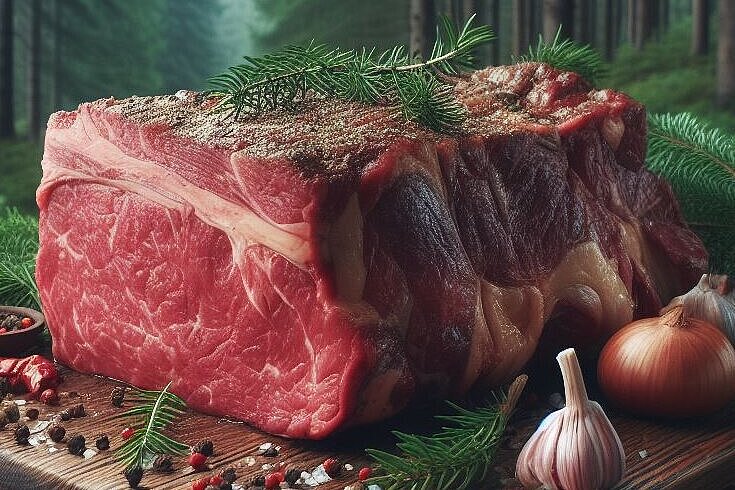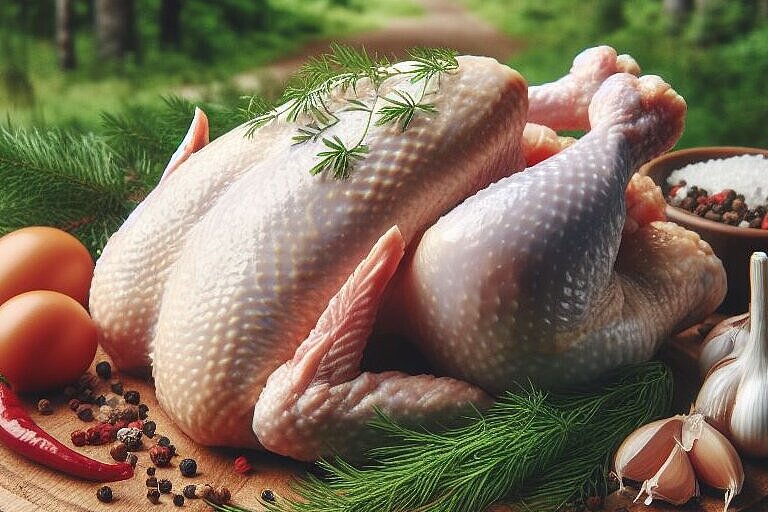Meat

What is meat?
Meat is the collective term for the muscle tissue of animals that is used as food. Meat can come from different animal species, such as beef, pork, poultry, lamb or game. Depending on the animal species and body part, meat has different properties, such as color, taste, texture and nutritional value.
Meat is a natural food source for dogs that comes from their ancestors, the wolves. Dogs are not pure carnivores, but omnivores that can also utilize plant foods. Nevertheless, meat is an important part of their diet as it provides them with many essential nutrients.
What are the benefits of meat for dogs?
Meat offers dogs many benefits for their health and well-being. Here are some of them:
- Meat is a high-quality source of protein, which is important for building and maintaining muscles, organs, skin and coat. Protein is also involved in many metabolic processes and supports the immune system.
- Meat contains many vitamins and minerals that are needed for various bodily functions. For example, red meat contains a lot of iron, which is important for the formation of red blood cells. Poultry meat is rich in vitamin B6, which is involved in energy production. Lamb provides a lot of zinc, which is important for wound healing.
- Meat has a high fat content, which serves as a source of energy and improves the taste. Fat also contains essential fatty acids, such as omega-3 and omega-6, which have an anti-inflammatory effect and promote skin and coat health.
- Meat has a high water content, which contributes to hydration and facilitates digestion.
- Meat satisfies dogs' natural instinct and need to chew. Chewing meat can also improve dental hygiene and prevent tartar.
What are the disadvantages of meat for dogs?
Meat can also have some disadvantages for dogs if it is not fed in moderation or is of poor quality. Here are some of them:
- Too much meat can lead to an oversupply of protein or fat, which can lead to digestive problems or obesity. Obesity can in turn increase the risk of various diseases, such as diabetes or joint problems.
- Too little meat can lead to an undersupply of protein or other nutrients, which can lead to deficiency symptoms or weakness. This can occur especially in puppies or older dogs.
- Poor quality or spoiled meat can contain bacteria or parasites that can lead to infection or illness. This can happen especially with raw or undercooked meat.
- Some dogs may be allergic or intolerant to certain types of meat. This can manifest itself in skin rashes, itching, diarrhea or vomiting.
Which meat is good for dogs?
In principle, dogs can eat almost any type of meat as long as it is fresh and of good quality. However, there are some differences between the various types of meat that you should take into account.
Beef
Beef is a good source of protein and also contains important nutrients such as iron and vitamin B12. However, it is also often high in fat, which is why it should be fed in moderation for overweight dogs. Beef can be served raw or cooked.
Chicken meat
Chicken is a low-fat source of protein and also contains important nutrients such as vitamin B6 and phosphorus. It can be served raw or cooked as long as it is fully cooked.
Poultry
Poultry, a generic term for chicken, turkey or duck, is another common source of meat for dogs. It is easily digestible, low in fat and also contains a lot of protein and B vitamins. Poultry can be a good choice, especially for older or overweight dogs. However, you should make sure that you do not give your dog raw poultry, as it can contain salmonella or other bacteria. You should also avoid feeding poultry bones, as they can splinter and harm your dog.
Pork
Pork is one of the most controversial meats for dogs. It has a high fat content and can therefore lead to digestive problems or pancreatitis. It can also contain the Aujeszky's virus, which can be fatal for dogs. Therefore, you should not give your dog raw or undercooked pork. If you want to feed your dog pork, you should cook it thoroughly and only offer it in small quantities.
Lamb
Lamb is a good source of protein and also contains important nutrients such as iron and vitamin B12. However, it also has a higher fat content than other types of meat, which is why it should be fed in moderation for overweight dogs.
Fish
Fish is an excellent source of protein for dogs and also contains important omega-3 fatty acids, which are good for your dog's heart and joints. However, fish should always be fully cooked or undercooked to avoid the risk of diseases such as anisakidosis.
Game meat
Game meat is a good source of protein and also contains important nutrients such as iron and vitamin B12. It is also often low in fat and can be well tolerated by dogs with sensitive digestion. However, game meat should always be cooked thoroughly to avoid the risk of diseases such as echinococcosis or Lyme disease.
How much meat should a dog get?
The optimum amount of meat for a dog depends on various factors, such as the dog's age, weight, activity level and state of health.
As a rule of thumb, an adult dog should get about 2 to 3 percent of its body weight in food per day, about half of which should be meat. This means, for example, that a 10 kilogram dog needs about 200 to 300 grams of food per day, of which 100 to 150 grams should be meat.
However, these figures are only guidelines and can vary depending on individual requirements. You should therefore always keep an eye on your dog's weight and condition.
What is hydrolyzed meat?
Hydrolyzed meat is a type of meat that has been specially developed for dogs with food intolerances or allergies. In the production of hydrolyzed meat, the meat is broken down into small peptides (protein fragments) so that it is no longer recognized by the dog's immune system and does not trigger an allergic reaction.
Advantages of hydrolyzed meat
Hydrolyzed meat can be beneficial for dogs with food intolerances or allergies as it allows them to have meat in their diet without developing allergic symptoms. It is also highly digestible and can help to alleviate digestive problems.
Disadvantages of hydrolyzed meat
Because the meat is broken down into small peptides during the production of hydrolyzed meat, it is often less flavorful than conventional meat and may be less preferred by dogs. It can also be more expensive than conventional meat.
But what is the best meat for your dog?
There are different ways to feed your dog:
- Dry food,
- wet food or
- BARF
Each of these options has its advantages and disadvantages. We'll tell you the differences between these types of food and what you should look out for when deciding which one to choose.
What is dry food?
Dry food is one of the most popular types of food for dogs. It consists of dried ingredients that are pressed into pellets or kibble. The advantage of dry food is that it has a long shelf life and is easy to store and portion. It can also promote your dog's dental hygiene, as it cleans their teeth as they chew.
However, dry food also has some disadvantages. For one thing, it can contain too little moisture, which can lead to dehydration or urinary tract problems. Secondly, it can contain too many carbohydrates or low-quality proteins, which can lead to obesity or allergies. In addition, dry food can be boring or unappetizing for some dogs.
What is wet food?
Wet food is another common type of food for dogs. It consists of moist ingredients that are packaged in cans or pouches. The advantage of wet food is that it contains more moisture, which is good for your dog's kidneys and digestion. It may also contain more meat or higher quality proteins, which are more important for the dog than carbohydrates. Wet food can also be more appealing to picky dogs as it has a more intense smell and taste.
However, wet food also has some disadvantages. For one thing, it can be more expensive than dry food and has a shorter shelf life. Secondly, it can contain too little fiber, which can lead to diarrhea or constipation. Wet food can also affect your dog's dental hygiene as it does not cause abrasion on the teeth.
What is BARF?
BARF stands for Biologically Appropriate Raw Food or Bones And Raw Food. It is a feeding method in which you give your dog raw meat, bones, offal and plant-based ingredients. The advantage of BARF is that it is based on the natural diet of your dog's ancestors and therefore provides all the nutrients your dog needs. You can also determine the quality and origin of the ingredients yourself and cater to your dog's individual needs.
However, BARF also has some disadvantages. On the one hand, it requires a lot of time and knowledge to prepare the food yourself and make it balanced. Secondly, it carries a risk of bacterial infections or injuries caused by bones or foreign bodies. BARF can also be expensive and difficult to store or transport.
How do you decide on the right food for your dog?
As you can see, there is no clear-cut answer to the question of what is the best food for your dog. Each type of food has its pros and cons and you need to weigh up what suits your dog and your lifestyle best. It is important that you inform yourself well.
Meat is the muscle tissue of animals that is used as food for dogs and other animals. It is an important source of protein and provides many essential nutrients. The benefits of meat for dogs are many, as it contains high-quality proteins, vitamins, minerals and healthy fats that can contribute to muscle development, immune defense, skin and coat health, energy supply and dental care.
Nevertheless, there are also some disadvantages and risks associated with feeding meat to dogs, especially if it is fed in excessive quantities or in poor quality. These include possible allergic reactions, digestive problems, obesity and the risk of parasites or pathogens in raw meat.
Choosing the best meat for your dog depends on several factors, including your dog's age, weight, health and preferences. Good meat can come from a variety of species, including beef, poultry, lamb, fish and game. It's important to choose high-quality and well-prepared meat sources and adjust the amount according to your dog's needs.
There are also different types of dog food, including dry food, wet food and BARF (Biologically Appropriate Raw Food). Each of these types of food has its own advantages and disadvantages, and the choice depends on your personal preferences and your dog's individual needs.
Properties 6
Are you looking for other ingredients with a specific property?
Just click on them to find more.
If you notice any signs of hypersensitivity or poisoning in your dog, you should see your vet immediately. We are not a substitute for a vet, but we try to be as accurate as possible. Every dog reacts differently and we recommend you get a second opinion or consult your vet if in doubt.
Stay healthy and take good care of your four-legged friend!😊
Similar to Meat
Beef is the meat of various breeds of domestic cattle (Bos taurus) that are bred for meat production. There are many different cuts of beef that are suitable as dog food. These include Muscle meat:...
Fish is a collective term for all animals that live in water and have gills. There are many different types of fish, which differ in size, shape, color and habitat. Fish are vertebrates and usually...
Chicken meat is the meat of domestic chickens bred for human and animal consumption. It is a type of poultry meat and is available in various cuts such as breast, thigh, wing or offal. Chicken meat...
Duck meat is the muscle meat of domestic and wild ducks. It is a type of poultry meat and has a high protein content. It also contains many important nutrients such as iron, zinc, selenium and B...



